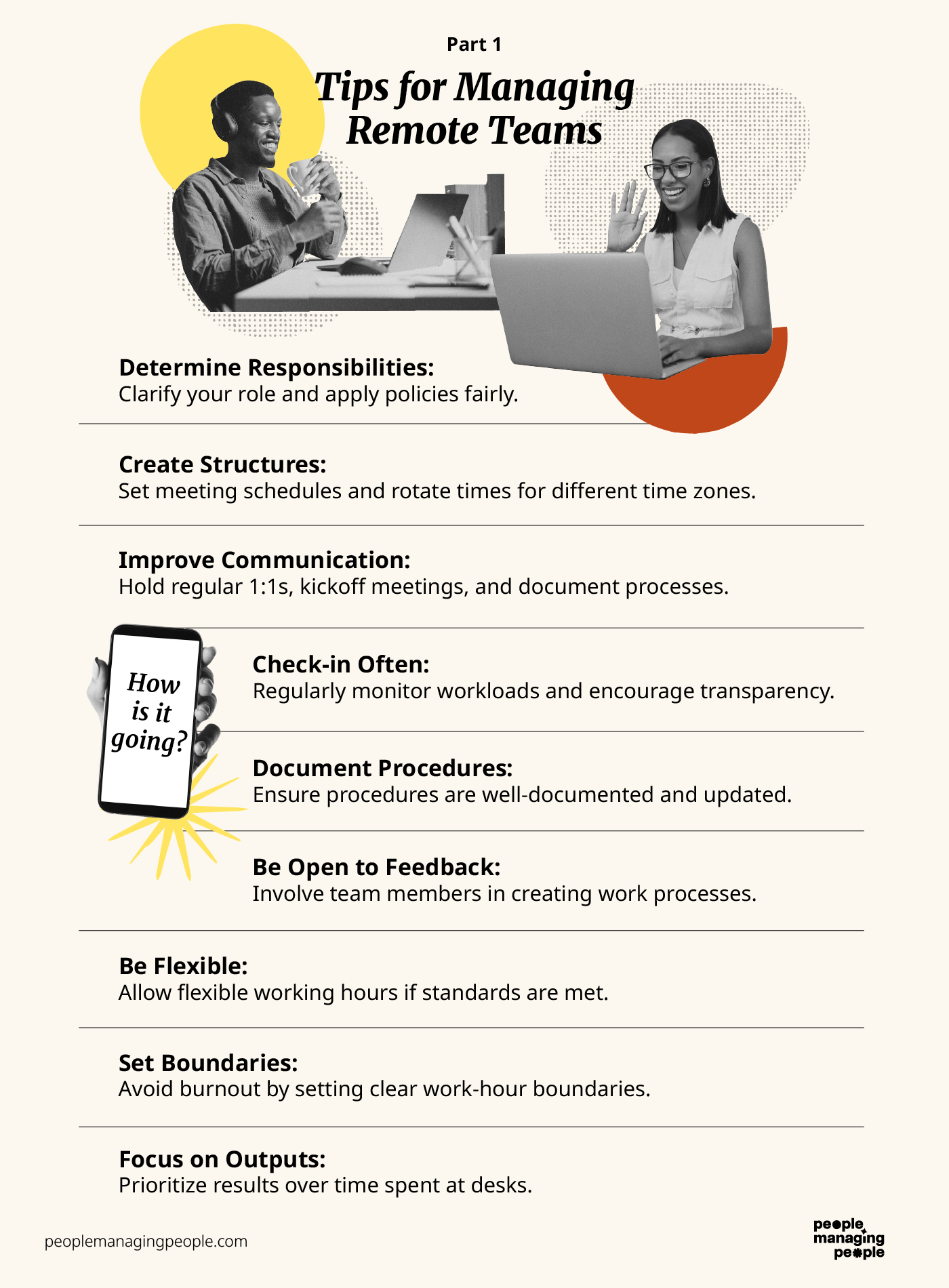Managing remote teams in 2025 isn’t about monitoring productivity—it’s about building alignment, autonomy, and trust across time zones.
Here’s what I’ve seen as the payoff:
- Stronger team alignment: Even across time zones, everyone knows the mission, the goals, and what happens next.
- Fewer bottlenecks: Clear roles, async updates, and documented processes mean less waiting and fewer Slack spirals.
- More autonomy, less micromanagement: When people know what “done” looks like, they don’t need you looking over their shoulder.
- Higher engagement: Trust leads to ownership—and people who care stick around longer.
- Reduced burnout: Expectations are clear, and people are judged on outcomes, not hours logged.
- Better output: Work improves when people have the flexibility to work in ways that work for them.
These practices are built on what we’ve learned managing our own distributed team, combined with insights from HR leaders, remote work research, and proven frameworks from across the industry. It’s a collection of what works—not just in theory, but in practice.
What Makes Managing Remote Teams Hard
Managing people is already tough. Doing it without the hallway chats, in-person energy, or shared time zones adds a new layer of friction. These are the common challenges I watch for—and how I know they’re starting to cause trouble.
1. Communication Breakdowns
What happens: Messages get misread. People work on the wrong thing. No one’s sure who owns what.
Early signs: You’re spending half your week clarifying things that “should’ve been obvious.” Team DMs start with “quick question” but turn into threads.
What helps: Clear norms on what communication tool to use when, async-first updates, and explicit next steps in every message.
2. Lack of Connection
What happens: The team starts to feel like a group of freelancers, not a team.
Early signs: Team calls feel flat. Fewer shout-outs, jokes, and organic collaboration. People show up right on time—and leave the second it ends.
What helps: Make space for casual moments. Use structured check-ins (like “word + number” openers) to read the room.
3. Invisible Overload
What happens: People burn out quietly. You don’t see the late nights or missed lunches—just the dip in output.
Early signs: Deadlines slip without warning. Energy is low. Team members seem vague or rushed in check-ins.
What helps: Weekly 1:1s that aren’t just task updates. Ask directly: “What’s feeling heavy right now?”
5. Blurred boundaries = burnout
What happens: Remote work bleeds into home life, and people don’t unplug.
Early signs: Replies at 10pm. Slack status says “away” but they’re still active. Fewer vacation requests.
What helps: Model boundaries yourself. Normalize signing off—and make it clear that performance isn’t tied to being online.
4. Eroding trust
What happens: Without visibility, some managers default to micromanaging—or team members start assuming the worst.
Early signs: Over-documenting. Passive-aggressive Slack messages. Hesitation around deadlines or decisions.
What helps: Focus on outcomes, not activity. Be consistent with feedback and celebrate wins publicly.
28 Best Practices for Leading Remote Teams
I’ve grouped these into five categories I rely on: communication, culture, clarity, tools, and trust. Use what fits your team—no need to do it all at once.

Communication: Make Clarity the Default
- Set communication norms
- Define what goes in Slack vs. email vs. meetings.
- Hold structured 1:1s and kickoff meetings
- These create rhythm and help surface issues early.
- Check in often
- Actively monitor workloads and encourage transparency, not just status updates.
- Over-communicate on purpose
- Don’t assume people read every message—repeat the important stuff.
- Respect time zones
- Rotate meeting times and default to async unless it’s urgent. When communication is intentional—not just immediate—you start to see the benefits of remote teams show up in real ways.
- Rotate meeting times and default to async unless it’s urgent. When communication is intentional—not just immediate—you start to see the benefits of remote teams show up in real ways.
You can’t just hire great talent without onboarding properly and setting those expectations if you’re going to retain them.
Culture: Build Belonging Without a Watercooler
- Normalize casual conversation
- Create Slack spaces or 5-min check-ins just for fun.
- Make face time count
- Use video intentionally—for 1:1s, retros, or tough convos.
- Do lightweight team rituals
- Try weekly wins, GIF battles, or “what I’m learning” shares.
- Be open to feedback
- Involve your team in creating and improving workflows.
- Recognize contributions often
- Celebrate small wins publicly, not just the big ones.
Clarity: Set People Up to Own Their Work
- Determine responsibilities clearly
- Be explicit about roles and apply hr policies fairly.
- Create structures that support alignment
- Standardize meeting rhythms and document expectations.
- Document your procedures
- Keep process docs current and accessible.
- Define what “good” looks like
- Add examples, clarify scope, and write clear briefs.
- Have recurring 1:1s
- Use your one-on-ones to unblock, align, and coach—not just check progress.
Tools: Make Work Feel Less Like Work
- Pick the right stack (then stick to it)
- Avoid tool sprawl. Use what the team actually adopts.
- Choose the best and most useful tools for remote collaboration, trust me it'll help improve your visibility overall.
- Automate the boring stuff
- Use Zapier, IFTTT, AirTable, or native tool integrations to reduce manual work.
- Use project management tools well
- Everything should live in one place. No more “where’s that doc?”
- Centralize documentation
- Use one source of truth—Notion, Confluence, Slite, etc.
- Create visibility with dashboards
- Let your team see progress, not just you.
Trust: Lead Like You Mean It
- Be flexible if outcomes are strong
- Trust people to work how they work best.
- Set and model boundaries
- Help your team avoid burnout by protecting off-hours.
- Focus on outputs, not desk time
- Value outcomes, not hours worked.
- Be transparent about priorities
- Share what’s changing and why—even if it’s messy.
- Check in on people, not just projects
- Ask “how are you?” and mean it.
- Spot burnout early
- Changes in tone, energy, or responsiveness are usually signals.
- Support growth and stretch goals
- Career chats on professional development should be part of the management rhythm.
- Stay consistent
- Trust builds when your team knows what to expect from you.
Managing Remote Teams Isn’t About Control—It’s About Clarity
Leading a remote team doesn’t mean reinventing how you manage. It just means getting sharper about how you communicate, how you build trust, and how you help people do great work without burning out.
The best-performing remote teams aren’t run by people-management superheroes—they’re run by managers who create consistency, make space for people to work well, and fix small problems before they become big ones.
Whether you’re managing a fully remote org or a hybrid team, these practices are meant to be lived—not just read. Pick a few weak spots. Tighten them up. Repeat.
Subscribe To The People Managing People Newsletter
For more tips and best practices on managing remote teams, subscribe to our weekly newsletter for HR and business leaders. You'll receive all out latest content to help you grow in your career and make greater impact in your org.


